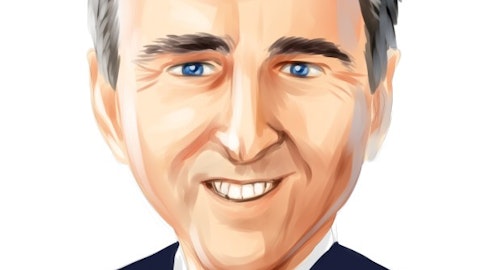We are used to that at QIAGEN. I still believe that labs on average, continues to renew and upgrade their instrumentation every five years. There is no scientific rules here, but it’s well adopted and well accepted KPI in our market. So whether it is capital sales or placement QIAGEN as the financial answers for all those options, it is true that it’s a bit more constrained. But once again, we believe that the market for diagnostic life science and clinical is solid and will continue at a pretty solid growth rate as well in the coming months. Roland, moving to the margin.
Roland Sackers: Sure. Yes, I think also the margin as you laid out wild days, I would say, still volatility and clearly also increasing uncertainty in the market. I do believe that we had shown in the past that we have our hands around our expenses quite well around, and I don’t think that is going to change going forward. So even in a more in brackets — in a scenario where you assume a more muted growth rate moving from ’23 to’ ’24, I still believe that we should be able to deliver actually also a very reasonable margin improvement. There is clearly — and we said it also on the call today, right now, we are rather accelerating some of our R&D investments because we do believe there is a good opportunity for us to invest. We continue to see more and more leverage opportunities on the sales and marketing side.
We have seen that trend on the administrative side. Now, I think for the last 24 months that we are here while we had lower overall revenues still have quite significantly reduced our admin expense ratio and there’s more potential around that as well. So all in, I think on the EBIT line, there should be even in a more difficult environment, enough room for us to improve margins.
Operator: The next question comes from Daniel Arias of Stifel. Your line is open. Please go ahead.
Unidentified Analyst: It’s Paul on for Dan. Just in terms of kind of getting a sense of your comfort level heading into 2024, you talked a little bit last quarter about being more or less comfortable with a sort of high single-digit growth trajectory, just kind of baseline expectation. Should we expect that, that’s come down since what we were kind of talking about three months ago? And do you have a sense for as inflation is normalizing and so forth, what the pricing realization might be just in terms of directionality for next year?
Thierry Bernard: Thank you, Paul. So, I’m not sure that I have ever seen a number like high single-digit growth for 2024. But what we have always said, we believe that we have the people and the product portfolio for QIAGEN, both life science and clinical diagnostic to be above market growth. And I still believe in this, wherever in that market. Once again, that market might be experiences some pressure and pressures those days, but it’s a good market. I believe that COVID-19 has definitely proven the relevance of life science diagnostics and clinical diagnostics in the health care value chain. This is not disappearing. So even if the market is a bit softer, it’s still a growing market. And what we feel at QIAGEN is that regardless the level of the market growth, we have the portfolio to be above that market growth.
At the moment, we are clearly focusing on achieving 2023 and our guidance in a volatile environment. As you know, we give our guidance for the year around early February. This is what we are going to do this year. But we strongly believe that we have the people and the product portfolio to systematically beat the market growth. On inflation, yes, it has receded compared to 2022. However, QIAGEN didn’t start to implement price increase because there was a hyperinflation last year. QIAGEN has a systematic policy of price increase every year around January well shared with our customers because we sell value. We sell innovation, and we invest in R&D. In a normalized environment, we believe that normal price increase of between 2.5%, 3.5% per year according to different geographies is what we need to look for.
And as I said before, I always think that net-net a company like QIAGEN in a normalized environment should expect a net-net impact of price increase of around 50 to 100 basis points.


